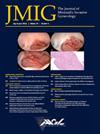单个中心经宫颈超声引导射频消融术对有症状子宫肌瘤的评估
IF 3.5
2区 医学
Q1 OBSTETRICS & GYNECOLOGY
引用次数: 0
摘要
研究目的关于经宫颈射频消融术(RFA)治疗子宫肌瘤的 Sonata 系统® 的大部分已发表数据均来自最初的临床试验。我们报告了我们的初步经验以及术后 18 个月的手术/药物再干预率,以研究 RFA 作为子宫切除术替代方案的实用性。患者或参与者2021年4月至2023年3月期间,在本机构使用Sonata系统®在超声引导下进行RFA治疗症状性子宫肌瘤的所有患者(n=51).干预对所有接受经宫颈RFA治疗症状性子宫肌瘤的患者进行回顾性病历审查.测量和主要结果审查了51份患者病历,每位患者治疗的肌瘤数量中位数为4个。患者的人口统计学特征和手术结果与该设备最初的试验结果相似。治疗的子宫肌瘤大小为 1-12 厘米,比装置临床试验中的 1-5 厘米大得多。没有出现与装置相关的并发症。使用卡普兰-梅耶尔分析法计算了术后 6 个月、12 个月和 18 个月的累积手术再介入率,结果发现分别为 2%、7.8% 和 24.3%。在需要再次手术干预的九名患者中,有四名患者接受了大型妇科手术,即子宫切除术或肌瘤切除术。此外,68.6%、62.7% 和 53.3% 的患者在术后 6 个月、12 个月和 18 个月内保持了无药物治疗间隔。与最初的试验相比,我们消融了更大的子宫肌瘤,同时在 18 个月内保持了较低的手术再干预率,这表明可能有比最初描述的更多患者有资格接受这种治疗。本综述为在门诊环境中实际使用 Sonata 系统®,指导患者选择和术前咨询提供了见解。我们有必要开展进一步的研究,在更多的患者群体中测试该系统,并了解长期疗效和真正避免子宫切除术的可能性。本文章由计算机程序翻译,如有差异,请以英文原文为准。
Evaluation of Transcervical Ultrasound Guided Radiofrequency Ablation of Symptomatic Uterine Fibroids in a Single Center
Study Objective
Most published data on the Sonata System® for transcervical radiofrequency ablation (RFA) of uterine fibroids is from the initial clinical trials. We report our initial experience and surgical/medical reintervention rates 18 months post-procedure to examine the utility of RFA as an alternative to hysterectomy.
Design
Single center retrospective chart review.
Setting
One clinical site.
Patients or Participants
All patients who underwent ultrasound-guided RFA for symptomatic fibroids using the Sonata System® at our institution between April 2021 and March 2023 (n=51).
Interventions
A retrospective chart review was conducted on all patients who underwent transcervical RFA of symptomatic fibroids.
Measurements and Main Results
51 patient charts reviewed, with a median of 4 fibroids treated per patient. Patient demographics and operative outcomes were similar to initial trials for the device. Treated fibroids ranged from 1-12cm, considerably larger those in the device clinical trials ranging 1-5cm. There were no device related complications. Cumulative surgical re-intervention rates at 6mo, 12mo, and 18mo postoperatively were calculated using Kaplan Meier analysis and found to be 2%, 7.8%, and 24.3%. Of the nine patients requiring surgical reintervention, four resulted in major gynecologic surgery, hysterectomy or myomectomy. Additionally, 68.6%, 62.7%, and 53.3% of patients maintained a medication free interval through 6mo, 12mo, and 18mo. 85.3% of patients discontinued hormonal therapy immediately postoperatively.
Conclusion
The Sonata System® for RFA can be considered an effective minimally invasive modality to treat symptomatic fibroids for the appropriate patient. We ablated considerably larger fibroids than in the initial trials while maintaining low surgical reintervention rates through 18months, suggesting more patients may be eligible for this treatment than initially described. This review provides insight into practical use of the Sonata System® in the ambulatory setting, to guide patient selection and preoperative counseling. Further studies are warranted to test the system in expanded patient populations, and to understand long-term outcomes and likelihood of true hysterectomy avoidance.
求助全文
通过发布文献求助,成功后即可免费获取论文全文。
去求助
来源期刊
CiteScore
5.00
自引率
7.30%
发文量
272
审稿时长
37 days
期刊介绍:
The Journal of Minimally Invasive Gynecology, formerly titled The Journal of the American Association of Gynecologic Laparoscopists, is an international clinical forum for the exchange and dissemination of ideas, findings and techniques relevant to gynecologic endoscopy and other minimally invasive procedures. The Journal, which presents research, clinical opinions and case reports from the brightest minds in gynecologic surgery, is an authoritative source informing practicing physicians of the latest, cutting-edge developments occurring in this emerging field.

 求助内容:
求助内容: 应助结果提醒方式:
应助结果提醒方式:


